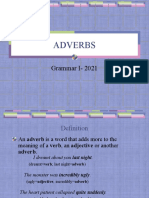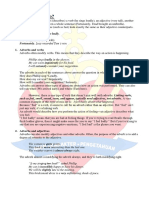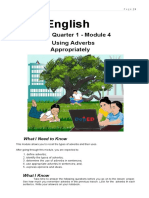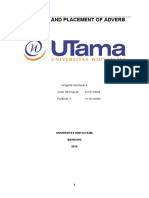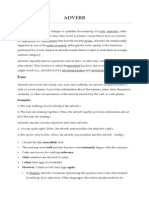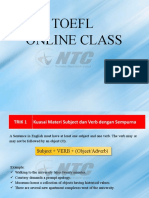Module 4 Topic Adverb
Uploaded by
Kpop ChannelModule 4 Topic Adverb
Uploaded by
Kpop ChannelAdverb
I. Key considerations
The term ‘adverb’ refers to different kind of words with quite different functions. For
teaching purposes it is generally necessary to specify particular types of adverb (e.g. adverbs
of manner), rather than refer to adverbs all together as thought they were a unified of
words.
Adverbs can occupy a range of positions in the sentence, and choosing where to place them
is often a major problem for learners.
The meaning of the certain adverbs (e.g. yet, already, ever ) is complex, and we may want to
avoid teaching these at the same time as other major grammatical features (e.g. tenses ).
II. What are adverbs ?
What do they do ?
The popular definition of adverb as words that ‘modify a verb, an adjective or another
adverb’ is neither accurate nor very helpful. Whereas it is relatively easy to define and
describe what a noun what a noun or an adjective is, we can only usefully define and define
and describe different categories of adverb. It is sometimes helpful to think of ‘adverb’ as a
‘dustbin’ term-all the types of word that don’t fit neatly into other categories such as noun,
adjective, verb, preposition are lumped together as adverbs.
The following is a useful way of dividing adverbs :
Manner : carefully, slowly
Frequency : always, often, never
Time and place : now, here
Relative time : already, recently, soon
Degree : extremely, rather, very
Quantity : a lot, a little
Focusing : even, also, only, particularly
Attitudes markers : apparently, fortunately
Focusing adverbs and attitude markers can also be classified as discourse markers.
Page | 1 English for Business Topic : Adverb
Many types of adverb can be seen in the following text, in which a family therapist is being
interviewed about jealousy. The adverbs in the text are printed in italics. Each of them is
classified below so that you know how these terms are use in this chapter.
John : so was jealousy a bit of a problem amongst you and your brothers? Robin : Absolutely (1 ).
Jealous squabbles were always (2) bursting out between us and our parents could never (3) find a
way of handling it successfully (4). ‘We can’t understand why they’re all so (5) jealous’, they’d say
to people. ‘We try to be fair’. And they were. But because jealousy frightened and worried them so
(6) much (7), we never (8) got the chance of being properly (9) jealous, finishing it, going through
it, and letting the feeling find its normal, natural place in our personalities. Still I’ve learned from
this, and nowadays (10), when families I see complain of jealousy in their children despite the fact
that they always (11) cut the cake equally (12) with the ruler and give anyone penicillin when only
(13) one child has a sore throat, I know what to do. I usually (14) tell them that, though they are
such a nice, successful family in many ways, they’re obviously (15) not very (16) good at being
jealous and need more practice before they come to see me next time.
(1) Attitude marker (9) degree
(2) Frequency (10) time
(3) Frequency (11) frequency
(4) Manner (12) manner
(5) Degree (13) focusing adverb
(6) Degree (14) frequency
(7) Quantity (15) attitude marker
(8) Frequency (16) degree
Grammars and dictionaries often disagree about what words are adverbs and what aren’t.
one-word textual discourse markers such as firstly, however and nevertheless are
sometimes classified as adverbs.
Page | 2 English for Business Topic : Adverb
What do they look like ?
ly
We form a lot of adverbs by adding ly to an adjective (e.g. ably, busily, calmly, oddly,
probably, usually ).
in most cases the meaning of the adjectives and adverbs are very close.
Adjective : he’s a careful driver
Adverb : he drives carefully
Although many adverbs end in ly, but all words which end in ly are adverbs. The followings
are adjectives : friendly, manly, leisurely, likely.
These do not have a standard adverb form. Some people say, for example :
*he smiled at her very friendly.
However, most people simply avoid sentences like this. It is more usual to use an
expression such as the following in a friendly / masterly / leisurely way.
Other adjectives (e.g. difficult ) have no adverb equivalent ( *difficulty). We use the
expression with difficulty in place of an adverb.
A few adverbs which are closely related to adjectives in for, don’t mean the same as the
corresponding adjective (e.g. hardly, hugely, simply,). This can be a source of confusion for
learners.
III. Other adverbs
Some adverbs (e.g. often, very, even ) can’t be identified as adverb by their spelling or
pronunciation.
A number of adverbs have the same form adjectives and there is no ly alternative (e.g. fast,
hard, next, freelance ).
Adjective : A freelance designer
Adverb : She’s working freelance.
Page | 3 English for Business Topic : Adverb
Other adverb have two forms – one is the same as the adjective and the other ( which
many people prefer and may consider to be the only correct form ) ends in ly.
Commonly used used formally and in written language
Hold it tight she held the bag tightly.
Come here quick she ran quickly.
Try to sing less loud He always spoke loudly
Is this plug sold separate ? additional RAM can be purchased separately ?
Well is the adverb that corresponds to the adjective good
He’s a good driver. (adjective)
He drives well. (adverb )
IV. Where do adverb come in sentences ?
General points
The rules which govern the position of adverb in sentences are complex. They take into
account what kind of meaning the adverb expresses and what information the speaker or
writer wishes to highlight. Some adverbs are an intrinsic part of phrases (e.g. adverb of,
manner, of degree, of quantity and some focusing adverbs ), and their position is
relatively inflexible. Other adverbs (e.g. attitude markers, adverb of time and place, and
adverb of frequency) may refer to whole clauses or to large parts of clauses, and their
position is more flexible.
We look in detail at the sentences position of specific adverbs and types of adverb below.
Before a whole clause : nowadays, when families… complain…
Before the verb : we never got the chance
Between the auxiliary could never find a way
in main verbs :
at the end of clause : a way of handling it successfully
before adverbials : cut the cake equally with a ruler
Page | 4 English for Business Topic : Adverb
before an adjective : properly jealous ; very good
before and adverb : jealously frightened and worried them so much
V. Types of adverbs
Adverbs of manner
In the following text, the adverb of manner are printed in italics. (Diana, Roger, and Snubby
are children, and Loony is a dog).
Diana and Roger had no wish to fling themselves joyfully on Snubby ; but Loony
flung himself on them so violently that he almost knocked Diana over. He appear
from under the table, barking madly, and threw himself at them.
‘hey – wait a bit!’ said Roger, very pleased to see Loony. The spaniel
licked him lavishly, whining joyfully. Miss pepper looked crossly at them.
‘Diana! Roger ! You are very late.’
‘Well’ said Diana indignantly… ‘It wasn’t our fault !’
Meaning
Adverbs of manner usually express how something is done.
Open it quickly he hit me hard
They can usually provided one – word answers to questions beginning how….
How did she approach them ? --- warily
Sentence position
The most common place to use adverbs of manner is at the end of a clause.
After a verb : you spoke convincingly
Page | 5 English for Business Topic : Adverb
After an object : you described everything convincingly
After an adverbial: you described everything to the board convincingly
However, we can vary the position of adverbs of manner according to what we ant
emphasis.
Before a subject : carefully, she put it on the shelf
Before a verb : she carefully put it on the shelf.
Between an object she put it carefully on the shelf.
and an adverbial
We also use adverbs of manner immediately before past participles.
The new roof was carefully lifted into position.
We generally avoid placing these adverbs between a verb and its object or a non-
finite or that clause.
*She made quickly the lunch, He opened cautiously the door.
However, this is not an absolute rule and learners will frequently come across
example of the adverb in this position.
… by learning to change our use of the self we affect fundamentally every aspect of
our experience.
Nonetheless, particularly in formal written language, many people disapprove of
placing an adverb between the particle and adverb in a ‘full’ infinitive form.
Learners may be penalized in examinations if they do this themselves.
*I want you to carefully open the door. =I want you to open the door carefully.
Adverbs which qualify adjectives
We can use adverbs of manner to qualify adjectives.
Loosely assembled notes a lightly poached egg rigorously critical
In most cases – but not all – these adjectives are formed from the past participle of a verb
and it can be argued that these are not strictly adjectives at all.
Page | 6 English for Business Topic : Adverb
A lot of adverbs of manner occur very frequently with particular types of verb or adjective,
and teachers often choose to teach these together. For example, flatly occurs most
frequently with forms of say with verb which suggest rejections (e.g. refuse, insist,
repudiate ). Passionately occurs with verbs like kiss ( e.g. dislike, care, believe ). Urgently
frequently occurs with verbs suggesting need : need itself, as well as required and request.
Adverbs of frequency
Meaning
We use adverbs of frequency to indicate how often we do things or how often
things happen. Adverbs of frequency include : always, usually, often, sometimes,
occasionally, hardly ever, seldom, rarely, never.
We always/usually/never get up early on Sundays.
Sentence position
Before the main verb
We usually tell learners that we place adverbs of frequency ‘immediately before the
main verb’. This rules thumb describes most cases where the verb phrase is a one-
word from (e.g. goes, spoke ) or where it comprises one auxiliary verb and a main
verb (e.g. has spoken, don’t believe).
She never speaks. They don’t always believe what I say.
Two auxiliary verbs
If there are two auxiliary verbs before a main verb (e.g. has been speaking would
have eaten), we generally place the adverb of frequency between the two
auxiliary verbs.
They would often have eaten before we arrived.
(to) be
When we use one- word forms ( am, is. Are, was, were ), we usually place adverbs
of frequency immediately before the complement.
I was always the best student. Is she often ill ?
Page | 7 English for Business Topic : Adverb
Front and end positions
For emphasis we can also choose to place usually, often, sometimes and
occasionally at the beginning of a whole clause.
Sometimes her attitude is rather off-putting.
We also place often and sometimes at the end of a clause, after the verb, object or
adverbial.
I wash up sometimes I don’t go out often
Phrases similar in meaning to adverbs of frequency (e.g. now and again, once a
while, from time to time ) usually occur only at the beginning or end of a clause.
‘Negative’ adverbs and word order
Some adverbs can be preceded by not ( not once, not often, not never, etc. ), and others
are intrinsically negative or restrictive in meaning (e.g. hardly (ever ), never, rarely,
scarcely, (ever ), seldom ).
When we place these at the front of a clause for emphasis, we use the word order of a
question form, i.e. ‘inversion’. This is more common in writing than in speaking.
Not once did she call in to see me.
Adverbs of time and place
We use adverbs to specify both times (e.g. yesterday, today ) and places (e.g. outside,
underneath ). We also use adverbs to stand in place of adverbials (phrases such as on
Wednesday or at the bus stop ) which make the precise time or place known.
The following four adverbs are very common, now, then, here, there.
I need to see her now
I’m seeing him at 6.00. I’ll tell him then.
While we’re here, can we see the garden ?
You can’t stay there too long.
We generally place these adverbs at the end of a clause.
Page | 8 English for Business Topic : Adverb
When we use adverb of time and place together, we usually specify the place before the
time.
She’s coming here now.
Words that we normally think of as prepositions are also sometimes used as adverb.
He continues on down.
Adverbs of relative time
Meaning
These adverbs provide information about the time of an accent or event in relation to
some other point of time ( often ‘now’ ).
He’s currently working in Namibia
They’re just coming
I’ll be there soon.
Sentence position
Just
we use just immediately before the main verb or between two auxiliary verbs.
I just saw him.
They have just arrived.
I have just been looking for you.
Afterwards and soon
We usually use afterwards and soon at the end of a clause.
We’re leaving afterwards
We’ll be at the station soon.
Page | 9 English for Business Topic : Adverb
Currently, presently and recently
The position of currently, presently and recently is more flexible. These adverbs
often :
• Come at the end of a clause : I’ll be going out presently.
• Precede a main verb : She’s currently trying to finish the book.
• Come between two auxiliary verbs : She has recently been getting back late.
These adverbs can also come at the beginning of a clause,, particularly in written
and more formal styles of English.
Presently, she got up from the bench and wandered down to the edge of
the stream.
Special adverbs: already, still and yet
Meaning
The meaning of these adverbs is difficult to tie down independently of context – it
often depends on assumptions we make about the knowledge and expectations our
readers or listeners share with us.
Consider the difference in meaning between the following sentences.
Is she here ? ( neutral enquiry )
Is she still here? ( I thought she might leave before now ).
Is she here yet?(we both know she is coming but I don’t know if she has arrived).
Is she here already ? ( has she come earlier then we expected? )
We need to pay particular attention to tone of voice in teaching these adverbs as in
question they can easily be interpreted as criticism ( have you finished yet ? = hurry
up! ).
In teaching these adverbs it is often helpful to refer to how these meanings are
expressed in the learners ‘first language(s)
Page | 10 English for Business Topic : Adverb
Sentence position
We usually place already and still :
• Immediately before the main verb
I already know. I am still using it.
• Between the verb (to) be and the complement.
They’re still teenagers.
We can also place these adverbs at the end of a clause.
I know already. I am using it still
We use yet at the end of a clause.
Has she finished yet ? they haven’t eaten yet.
Already is generally used in affirmative statements but may be used in questions,
especially in American English.
Adverbs of degree
Meaning
We divide adverbs of degree into ‘intensifiers’ (e.g. extremely, very, really, so ), which
make adjectives and other adverb stronger, and ‘downtowners’ or’ mitigators’ (e.g.
fairly, quite, rather ), which make them weaker.
Intensifiers : we are very hungry
I am totally confused
Downtowners : we ran fairly quickly.
Choosing an intensifier depends not only on the degree of intensification (e.g.
extremely, is stronger than very ) but also on the meaning of what we want to
intensify, the grammar of what is intensified ( e.g. adjective or verb ) and on style.
Some adjectives are gradable and we choose intensifiers such as very or extremely.
With ungradable adjectives we choose intensifiers which express absoluteness such as
absolutely, completely or totally. Other intensifiers such as largely, and wholly
comment on the completeness of something. We use some intensifiers only to
describe abstract qualities (e.g. massively successful, hugely ambitious ).
Page | 11 English for Business Topic : Adverb
The intensifiers we use with gradable adjectives can also be used with adverbs (e.g.
extremely badly, really soon, and we can use a few adverbs with verbs (e.g. I really like
it, I totally agree ).
Some common intensifiers such as awfully, really, and terribly are used mainly in
informal spoken English.
We use downtowners only with gradable adjectives such as angry, cold, hot or with
related adverbs such as angrily.
We can use quite with both gradable and ungradable adjectives (and relater adverbs ),
and its meaning changes accordingly. Quite functions as a downtowners with gradable
adjectives and adverbs (e.g. quite= fairly), and expresses absoluteness with ungradable
adjectives (e.g. quite = totally ). We also use different stress and intonation with the
different meanings of quite.
She was quite tired. (gradable )
She was quite exhausted ( ungradable )
Sentence position
We generally place adverbs of degree immediately before the word they qualify, e.g.
very old ( adjective ), terribly quickly (adverb ), really like (verb ) .
When the verb phrase contains a modal verb (e.g. can, may, might, should ), we can
use the adverb before the main verb according to which word it qualifies.
Before the modal verb : you really must look at the garden
Before the main verb : you must really look at the garden
We usually place adverbs of degree immediately before the main verb when auxiliaries
are used to form the tense.
I have quite enjoyed the holiday
As well as placing very much before the verb, we can also place it at the end of the
clause.
I appreciate your help very much
Page | 12 English for Business Topic : Adverb
Adverbs of quantity
A lot, a little and much tell us something about quantity. We consider the expressions a
lot and a little in this chapter ( which is mainly concerned with single-word forms)
because they have no one-word equivalent.
We generally use a little only in affirmative statements and much in negative or question
forms. We can use a lot in affirmative and negative statements and in questions.
She cried a little/a lot
She doesn’t go out much/a lot
Do they complain about the service much/a lot ?
We generally place these adverbs at the end of a clause
Focusing adverbs
Meaning
We use focusing adverbs:
• To single out information (e.g. especially, even. Particularly, specifically ).
• To express some kind of restriction ( e.g. just, merely, only, purely ).
• To refer back to something ( e.g. also, either, too).
these adverbs help us to structure what we say or write, and in this way they
are closely related to discourse markers.
The meaning of focusing adverbs is particularly dependent on the context we
use them in and the knowledge we share with our readers in participants on
the conversation. Each verbs has its own rules about what kinds of words it can
be used with and where it comes in the sentence, and we can use a good
dictionary to check these factors.
In this section we concentrate on three examples of focusing adverbs, even,
only and also.
Even
We use even to indicate that something is unexpected or surprising, or that it
reaches an unexpected or surprising degree of extreme.
Everyone is lying to me – even you.
Page | 13 English for Business Topic : Adverb
Only
We use only to express some kind of restriction.
I was only asking you a simple question. (i.e. I was asking you a simple
question and doing no more than this) .
Also
We use also to draw attention to the fact that we are adding information
about something.
You have to teach the affirmative form of verbs and also the question form.
Sentence position
The position of even, only and also in sentence is particularly flexible
(although different position may change what the sentence means). We
usually place them immediately before the item they qualify.
Before the sentence subject : even the doorman smiled as they left.
Before the main verb : the doorman even smiled as they left.
Before conjunction + clause : the doorman smiled even as they lifted.
Focusing adverbs can refer to single words, which may belong to any word
class, or to phrases or longer stretches of language.
Pronoun : she invited even me.
Verb phrase : I also want to leave.
Clause : she left only what she didn’t need.
Attitude markers
Among the words that can function as attitude markers are : apparently, blindly, clearly,
hopefully, fortunately, frankly, naturally, obviously, ostensibly, really, stupidly, surprisingly,
unfortunately.
There are also sometimes called ‘sentence adverbs’.
Page | 14 English for Business Topic : Adverb
Meaning
We use attitude markers to interpret the events we describe or to convey our
attitude towards them. Attitude markers usually refer to a whole clause or longer
stretch of speech or writing.
I’ll invite you, naturally.
Clearly, we’ll want you to sign a contract.
Apparently they tried to call the doctor several times.
Most attitude markers can also function as an adverb of manner.
The dog wagged her tail hopefully. (adverb of manner )
They’ll be here, hopefully, by 5 o’clock. (attitude marker )
Some people disapprove of the use of hopefully as an attitude marker.
Sentence position
The position of attitude markers in sentences is very flexible. For example, we can
place them :
• At the beginning of clause: obviously no one is going to blame you.
• At the end of a clause: they call the doctor several times, apparently.
• Before a complement: she’s obviously a born teacher.
• Between a subject and verb : you naturally want to get the recognition for
what you achieve.
Typical difficulties for learners
Comprehension
Not knowing or identifying adverbs often poses less of a problem to learners than not knowing
or not identifying nouns and adjectives, although occasionally the meaning of an adverb may be
crucial. For example, adverbs of manner can convey essential information,
Open it gently
Problem with the grammar of adverbs rarely impede understanding.
Page | 15 English for Business Topic : Adverb
Speaking and writing
Using adjectives instead of adverbs
Learners sometimes use adjectives in place of adverbs of manner.
*she paints beautiful. *she improved rapid.
Over – using ly endings
Learners sometimes over – generalize the rule that adverb are created by adding ly to the
corresponding adjective, not knowing or realizing that there are a number of exceptions to this.
*she work hardly. * she speak ghastly.
Adjectives with no corresponding adverb form
Although in some varieties of English example like the following are common, most teacher
would consider them to be mistakes.
(*)she greeted us really friendly. (*)she teaches very lively.
Sentence position
Learners very often place adverbs after a verb and before a direct object.
*I like very much music. *She opened carefully the door.
Mistakes of this kind are particularly common among learners in whose first language this
would be the correct order.
Many other mistakes may occur where there are fixed, and seemingly arbitrary, rues which
govern the sentence position of particular adverbs.
*I have made also new friends
*Have you yet been there ?
*I have too tried ice- skating.
Learners may also be unaware or may forget that the subject and verb phrase are inverted after
a ‘negative’ adverb placed at the beginning of a sentence for emphasis.
*Rarely we ever saw him.
*Not often she managed to get here on time.
Page | 16 English for Business Topic : Adverb
Not … never
Never (= not ever ) is already negative and in standard English we can’t make it negative again.
*I’m very starving. *It’s very excellent news.
Using intensifiers with verbs
In the following cases we can use really to intensify the verb, but not very or extremely.
*I very like it. *Do you extremely miss me ?
Mistake of this type are particularly common among learners whose first language is Chinese or
Russian .
Yet and already
Learners may not know or may forget that yet is normally used only in negative and question
forms, and already only in affirmative statements.
*I have yet finished. *I haven’t already done it.
The meaning of focusing adverbs
Since differences in meaning can be very subtle, learners are apt to make mistaken (and
possible confusing ) choices.
*you can only sit at home and browse the internet. ( intended meaning: just sit at home ).
Reference:
Parrott, M. 2011. Grammar for English Language Teachers (2nd edition). United Kingdom :
Cambridge University Press
Page | 17 English for Business Topic : Adverb
Exercises
Language in context
1. The following text is from a ‘circular letter’ sent to old friends. The adverbs have been
printed in italics. Read the text and answer the questions that follow.
It’s nearly Christmas – a time when I traditionally (1) make efforts to renew
contact with friends individually (2) and when I think about you all and about what
is particularly (3) special about each and every one of you.
This year, however, I am afraid I am writing to you collectively (4) – I’ll be
thinking of each of you individually (5) as I sign and address your card. I hardly
ever (6) seem to have the time to sit down nowadays (7) and partly (8) I thought
this would be better than nothing and partly (9) also (10) want to practice my word
processing.
a) What category of adverb (e.g. adverb of degree) does each of these
items belong to?
b) What alternative words or expressions could be used without changing
the meaning?
c) Which adverb cold be used in an alternative sentence position?
2. Look at the following brief texts and answer the questions.
He explain grammar effectively and simply
I’m interested in the quality of the product and not simply how
many units we can sell.
It went completely over my head
I still make mistakes when I’m tired
Page | 18 English for Business Topic : Adverb
Woody Allen boldly goes into now territory – a Fatal attraction-
style thriller with laughs – to produce an elegantly written
beautifully acted film.
The slight sum of a motor vibrates softly in the air as if the hospital
was a huge ship ploughing confidently through the darkness. We sit
for a while un reception in the big vinyl chairs and watch the revolving
doors before going outside and taking a turn around the empty
visitor’s car park, laid our like a huge hope-scotch.
a. Which words are adverbs?
b. What category of adverb (e.g. adverb of degree etc.) does each of these
words belong to?
c. What effect would removing these adverbs from the texts have?
Page | 19 English for Business Topic : Adverb
You might also like
- (Ebook) Complete Italian All-in-One (Practice Makes Perfect), 2nd Premium Edition by Marcel Danesi ISBN 9781265764937, 126576493X all chapter instant download100% (14)(Ebook) Complete Italian All-in-One (Practice Makes Perfect), 2nd Premium Edition by Marcel Danesi ISBN 9781265764937, 126576493X all chapter instant download65 pages
- Placement Options For Adverbs: Patiently Patiently PatientlyNo ratings yetPlacement Options For Adverbs: Patiently Patiently Patiently12 pages
- Adverbs - Common List in American EnglishNo ratings yetAdverbs - Common List in American English13 pages
- Adverbs - Compiled by Shaharuddin Othman: Type Adverb ExampleNo ratings yetAdverbs - Compiled by Shaharuddin Othman: Type Adverb Example15 pages
- Adverbs: Ly Serve An Adverbial Function and An - Ly Ending Is Not A Guarantee That A Word Is An Adverb. TheNo ratings yetAdverbs: Ly Serve An Adverbial Function and An - Ly Ending Is Not A Guarantee That A Word Is An Adverb. The8 pages
- What Is An Adverb?: Fortunately, Lucy Recorded Tom's WinNo ratings yetWhat Is An Adverb?: Fortunately, Lucy Recorded Tom's Win6 pages
- What Is An Adverb Definition, Types & Examples 2No ratings yetWhat Is An Adverb Definition, Types & Examples 21 page
- Function and Placement of Adverb: Anggota Kelompok 4 Jogi Reynaldi 0119123004 Faishal K 0119123020No ratings yetFunction and Placement of Adverb: Anggota Kelompok 4 Jogi Reynaldi 0119123004 Faishal K 011912302010 pages
- Asst. Prof. DR .Ameer Ali Hussein: Shahad Kareem HadiNo ratings yetAsst. Prof. DR .Ameer Ali Hussein: Shahad Kareem Hadi13 pages
- Unlike Adjectives, Adverbs Do Not Modify NounsNo ratings yetUnlike Adjectives, Adverbs Do Not Modify Nouns6 pages
- Adverbs Adverbs Adverbs Adverbs: Adverbs Usually Answer The Following QuestionsNo ratings yetAdverbs Adverbs Adverbs Adverbs: Adverbs Usually Answer The Following Questions7 pages
- Adverbs: Qualifying Actions, Descriptions, and Claims: WWW - Sjsu.edu/writingcenterNo ratings yetAdverbs: Qualifying Actions, Descriptions, and Claims: WWW - Sjsu.edu/writingcenter3 pages
- Kelompok 4: Jogi Reynaldi - 0119123004 Faisal K - 0119123020No ratings yetKelompok 4: Jogi Reynaldi - 0119123004 Faisal K - 011912302015 pages
- 7 Days to Grammar Excellence: How to Master English from Beginner to AdvancedFrom Everand7 Days to Grammar Excellence: How to Master English from Beginner to AdvancedNo ratings yet
- Types of Meanings Expressed by Adverbial GroupsNo ratings yetTypes of Meanings Expressed by Adverbial Groups4 pages
- Delhi Public School, Srinagar English Revision Worksheet Class VNo ratings yetDelhi Public School, Srinagar English Revision Worksheet Class V2 pages
- Non-Chronological Report Reading - Year 2No ratings yetNon-Chronological Report Reading - Year 212 pages
- Be: Present Simple Form: They People and Things100% (1)Be: Present Simple Form: They People and Things63 pages
- Adjective Clauses: This Is The House That Jack BuiltNo ratings yetAdjective Clauses: This Is The House That Jack Built6 pages
- A. Meaning and Purpose of Descriptive TextNo ratings yetA. Meaning and Purpose of Descriptive Text7 pages
- Inglés I Mg. Nancy León Pereyra Showing Possession: Possessive Adjectives and PronounsNo ratings yetInglés I Mg. Nancy León Pereyra Showing Possession: Possessive Adjectives and Pronouns6 pages
- (Ebook) Complete Italian All-in-One (Practice Makes Perfect), 2nd Premium Edition by Marcel Danesi ISBN 9781265764937, 126576493X all chapter instant download(Ebook) Complete Italian All-in-One (Practice Makes Perfect), 2nd Premium Edition by Marcel Danesi ISBN 9781265764937, 126576493X all chapter instant download
- Placement Options For Adverbs: Patiently Patiently PatientlyPlacement Options For Adverbs: Patiently Patiently Patiently
- Adverbs - Compiled by Shaharuddin Othman: Type Adverb ExampleAdverbs - Compiled by Shaharuddin Othman: Type Adverb Example
- Adverbs: Ly Serve An Adverbial Function and An - Ly Ending Is Not A Guarantee That A Word Is An Adverb. TheAdverbs: Ly Serve An Adverbial Function and An - Ly Ending Is Not A Guarantee That A Word Is An Adverb. The
- What Is An Adverb?: Fortunately, Lucy Recorded Tom's WinWhat Is An Adverb?: Fortunately, Lucy Recorded Tom's Win
- Function and Placement of Adverb: Anggota Kelompok 4 Jogi Reynaldi 0119123004 Faishal K 0119123020Function and Placement of Adverb: Anggota Kelompok 4 Jogi Reynaldi 0119123004 Faishal K 0119123020
- Asst. Prof. DR .Ameer Ali Hussein: Shahad Kareem HadiAsst. Prof. DR .Ameer Ali Hussein: Shahad Kareem Hadi
- Adverbs Adverbs Adverbs Adverbs: Adverbs Usually Answer The Following QuestionsAdverbs Adverbs Adverbs Adverbs: Adverbs Usually Answer The Following Questions
- Adverbs: Qualifying Actions, Descriptions, and Claims: WWW - Sjsu.edu/writingcenterAdverbs: Qualifying Actions, Descriptions, and Claims: WWW - Sjsu.edu/writingcenter
- Kelompok 4: Jogi Reynaldi - 0119123004 Faisal K - 0119123020Kelompok 4: Jogi Reynaldi - 0119123004 Faisal K - 0119123020
- 7 Days to Grammar Excellence: How to Master English from Beginner to AdvancedFrom Everand7 Days to Grammar Excellence: How to Master English from Beginner to Advanced
- Delhi Public School, Srinagar English Revision Worksheet Class VDelhi Public School, Srinagar English Revision Worksheet Class V
- Adjective Clauses: This Is The House That Jack BuiltAdjective Clauses: This Is The House That Jack Built
- Inglés I Mg. Nancy León Pereyra Showing Possession: Possessive Adjectives and PronounsInglés I Mg. Nancy León Pereyra Showing Possession: Possessive Adjectives and Pronouns









